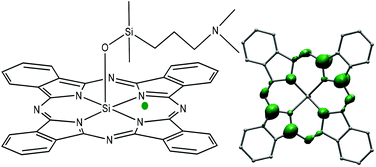Synthesis, properties and drug potential of the photosensitive alkyl- and alkylsiloxy-ligated silicon phthalocyanine Pc 227
Abstract
The photosensitive, alkyl- and alkylsiloxy-ligated silicon phthalocyanine, SiPc[(CH2)3SH][OSi(CH3)2(CH2)3N(CH3)2], Pc 227, has been prepared and characterized. This phthalocyanine yields the experimental photodynamic therapy (PDT) drug Pc 4, SiPc[OH][OSi(CH3)2(CH2)3N(CH3)2], when irradiated with red light. To provide an understanding of the process by which Pc 227 and other alkyl-alkylsiloxysilicon phthalocyanines such as Pc 227 are photolyzed, bond dissociation energy, natural bond orbital (NBO) charge distribution, spin density distribution, nucleus-independent chemical shift (NICS), and electron localization function (ELF) calculations have been carried out on two models related to it. These show that the lowest energy pathway for the photolysis of Pc 227 is a homolysis involving a phthalocyanine π radical having a low SiPc–C bond dissociation energy. The promise of the results of this study for synthetic chemistry and drug development is discussed.


 Please wait while we load your content...
Please wait while we load your content...